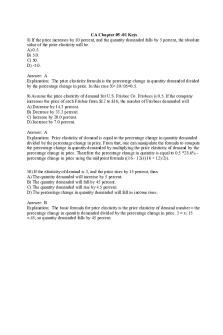Elasticity and Its Application PDF

| Title | Elasticity and Its Application |
|---|---|
| Course | Prin Microeconomics |
| Institution | The City College of New York |
| Pages | 3 |
| File Size | 88.5 KB |
| File Type | |
| Total Downloads | 84 |
| Total Views | 150 |
Summary
Download Elasticity and Its Application PDF
Description
Elasticity and Its Application The Elasticity of Demand Elasticity: a measure of the responsiveness of quantity demanded or quantity supplied to one of its determinants. To a change in one of its determinants. The Price Elasticity of Demand and its Determinants Price Elasticity of Demand: a measure of how much the quantity demanded of a good responds to a change in the price of that good, computed as the percentage change in quantity demanded divided by the percentage change in price. Loosely speaking, it measures the price-sensitivity of buyers’ demand. Price Elasticity of Demand= percentage change in Q percentage change in P Elastic: quantity demanded responds substantially to changes in the price. Demand is considered elastic when Elasticity is Greater than 1. Inelastic: quantity demanded responds only slightly to change in the price. Demand is considered inelastic when the Elasticity is Less than 1. Necessities versus Luxuries Necessities tend to have inelastic demands, whereas luxuries have elastic demands. Availability of Close Substitutes Goods with close substitutes tend to have more elastic demand because it is easier for consumers to switch from that good to others. Example:Butter and Margarine A small increase in the price of butter, causes the quantity of butter sold to fall by a large amount. Definition of Market Narrowly defined markets tend to have more elastic demand than broadly defined markets, because it is easier to find close substitutes for narrowly defined goods. Example: Food, a broad category, has a fairly inelastic demand because there are no good substitutes for food. Ice cream, a more narrow category, has a more elastic demand because it is easy to substitute other desserts for ice cream.
Time Horizon Goods tend to have more elastic demand over longer time horizons. Midpoint Method The midpoint is the number halfway between the start and end values. Price elasticity is higher when close substitutes are available. Price elasticity is higher for narrowly defined goods than for broadly defined ones. Price elasticity is higher for luxuries than for necessities. Price elasticity is higher in the long run. Variety of Demand curves Demand is elastic= Price elasticity of demand > 1 Demand is inelastic= Price elasticity of demand < 1 Demand has unit elasticity= Price elasticity of demand = 1 The flatter the demand curve, the bigger the elasticity. The steeper the demand curve, the smaller the elasticity. Revenue A price increase means revenue increases on each unit, but you sell fewer units because of the law of demand Revenue = P x Q When a demand curve is inelastic (a price elasticity less than 1), a price increase raises total revenue, and a price decrease reduces total revenue. When a demand curve is elastic (a price elasticity greater than 1), a price increase reduces total revenue, and a price decrease raises total revenue. In the special case of unit elastic demand (a price elasticity exactly equal to 1), a change in the price does not affect total revenue. If we have a lot of substitutes and price rises, revenue will fall. If % change in Q is greater than % change in P, revenue falls. Output effect: lose money when price rises Price effect: make money when price rises
Elastic Demand: Price goes up, Revenue goes down & Price goes down, Revenue goes up.
Inelastic Demand:Price goes up, Revenue goes up & Price goes down, Revenue goes down. Substitutes: Elasticity is GREATER than 0 Compliments: Elasticity is LESS than 0 Normal Good: Elasticity is GREATER than 0 Inferior Good: Elasticity is LESS than 0 Cross-Price Elasticity of Demand=Percentage change in Q demanded of good 1 Percentage change in the price of good 2
Price elasticity of supply = Percentage change in quantity supplied Percentage change in price Perfectly Inelastic Supply: Elasticity Equals 0 (D Curve Vertical) Inelastic Supply: Elasticity Is Less Than 1 (D Curve Relatively Steep) Unit Elastic Supply: Elasticity Equals 1 (D Curve Intermediate Slope) Elastic Supply: Elasticity Is Greater Than 1 (D Curve Relatively Flat) Perfectly Elastic Supply: Elasticity Equals Infinity (D Curve Horizontal) The slope of a linear demand curve is constant, but its elasticity is not....
Similar Free PDFs

Elasticity and Its Application
- 3 Pages

DIFFERENTIATION AND ITS APPLICATION
- 78 Pages

ME and its advance application
- 34 Pages

STRESS AND ELASTICITY
- 91 Pages

Elasticity and Demand Exercise
- 3 Pages

Incentives & Elasticity
- 2 Pages

Chapter 6 Elasticity and Demand
- 17 Pages
Popular Institutions
- Tinajero National High School - Annex
- Politeknik Caltex Riau
- Yokohama City University
- SGT University
- University of Al-Qadisiyah
- Divine Word College of Vigan
- Techniek College Rotterdam
- Universidade de Santiago
- Universiti Teknologi MARA Cawangan Johor Kampus Pasir Gudang
- Poltekkes Kemenkes Yogyakarta
- Baguio City National High School
- Colegio san marcos
- preparatoria uno
- Centro de Bachillerato Tecnológico Industrial y de Servicios No. 107
- Dalian Maritime University
- Quang Trung Secondary School
- Colegio Tecnológico en Informática
- Corporación Regional de Educación Superior
- Grupo CEDVA
- Dar Al Uloom University
- Centro de Estudios Preuniversitarios de la Universidad Nacional de Ingeniería
- 上智大学
- Aakash International School, Nuna Majara
- San Felipe Neri Catholic School
- Kang Chiao International School - New Taipei City
- Misamis Occidental National High School
- Institución Educativa Escuela Normal Juan Ladrilleros
- Kolehiyo ng Pantukan
- Batanes State College
- Instituto Continental
- Sekolah Menengah Kejuruan Kesehatan Kaltara (Tarakan)
- Colegio de La Inmaculada Concepcion - Cebu








